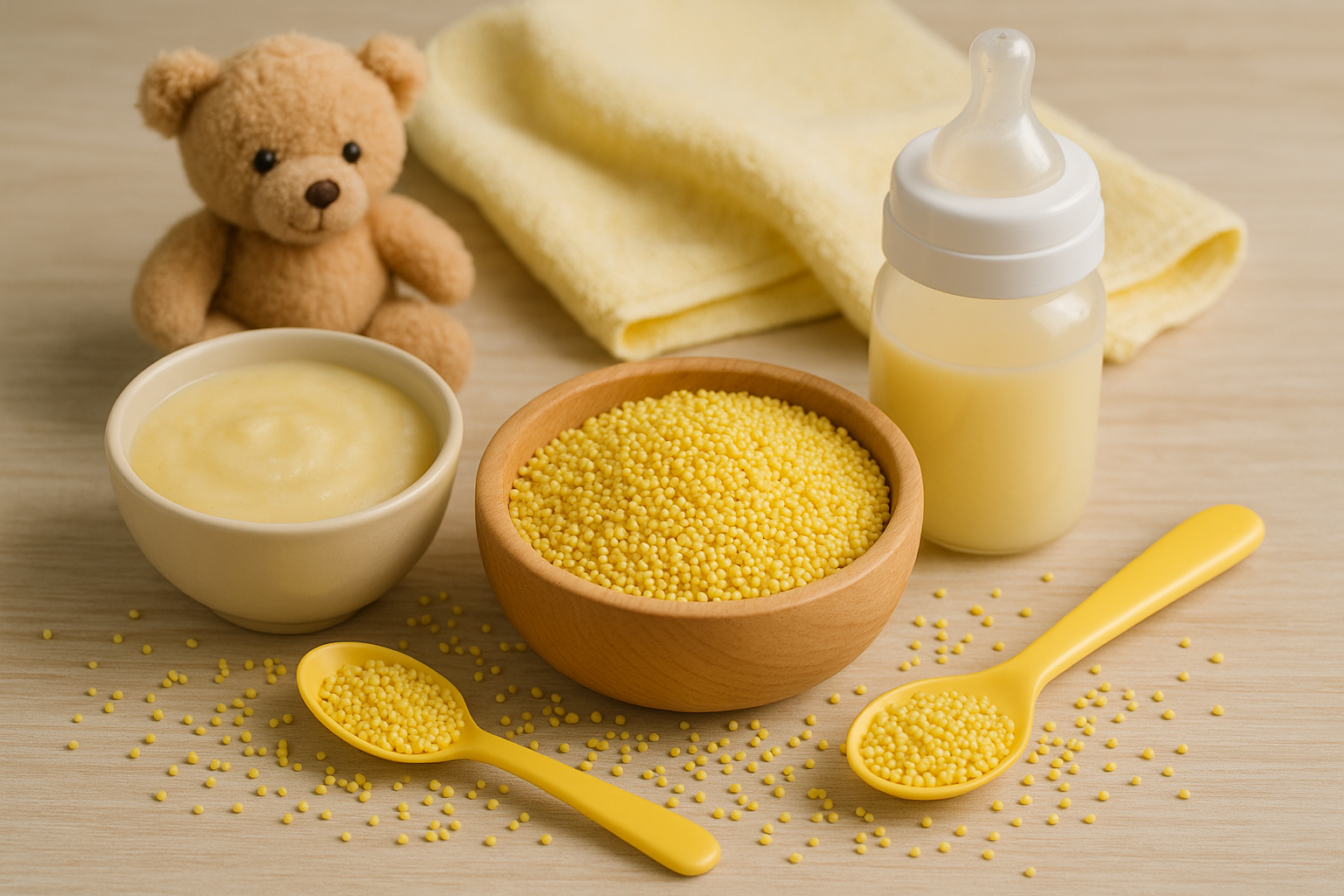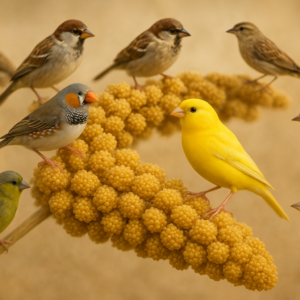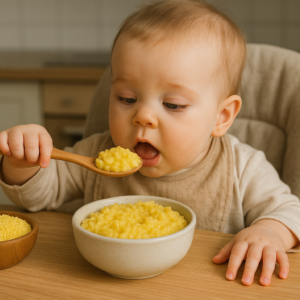Parents face countless decisions when choosing the right foods for their little ones. Yellow millet, also known as foxtail millet, stands out as a time-tested grain that has nourished babies for centuries. This small golden seed packs a powerful nutritional punch that supports your baby’s growth during those critical early months.
Let’s break it down. Yellow millet offers a gluten-free alternative to wheat-based cereals, making it perfect for babies with sensitive digestive systems. Its mild, slightly sweet flavor appeals to young palates while delivering the nutrients growing bodies need.
What Makes Yellow Millet Special for Babies?
Yellow millet belongs to a family of ancient grains that have sustained communities across Asia and Africa for thousands of years. The grain provides carbohydrates, fiber, and protein, along with calcium, folate, vitamin B6, and zinc, plus antioxidants and iron.
Foxtail millet is rich in B vitamins due to its yellow color texture, which supports a baby’s nervous system and skin care. The grain’s small size and soft texture when cooked make it easy for babies to manage as they learn to eat solid foods.
Agricultural suppliers like CMS Industries recognize the growing demand for quality grains. The company sources premium grains that meet international standards, providing families access to nutritious options for their children.
Top 15 Yellow Millet Benefits for Baby
1. Gentle on Developing Digestive Systems
Foxtail millet is known for being easily digestible, making it a great choice for introducing grains to babies. The grain’s smooth texture breaks down gently in tiny tummies, reducing the likelihood of digestive discomfort.
2. Rich Protein Source for Growth
The protein content in foxtail millet supports healthy cell function and tissue development in babies. Protein serves as a building block for every cell in your baby’s rapidly developing body.
3. Boosts Energy Levels
B vitamins contribute to energy production, keeping your little one active and thriving. Babies need sustained energy to fuel their exploration, play, and learning activities throughout the day.
4. Strengthens Bones and Teeth
Millet offers calcium in addition to other minerals, which plays a critical role in bone development. Strong bones provide the foundation for physical milestones like sitting, crawling, and walking.
5. Supports Brain Development
The presence of protein is higher than wheat and plays a very important role in the body of a growing baby. Brain cells require adequate protein to form connections that support learning and cognitive function.
6. Gluten-Free Alternative
Millets are gluten-free, and rich in fibre grain that is a nutritious, highly digestible grain. This makes yellow millet perfect for babies with gluten sensitivities or those whose families want to delay gluten introduction.
7. High in Dietary Fiber
Rich in fiber and complex carbs, so eases out constipation issues common in babies and keeps them full for longer. Fiber supports healthy bowel movements and helps prevent the discomfort of constipation.
8. Provides Essential Minerals
High source of minerals and very important nutrients, including calcium, copper, manganese, phosphorus, and magnesium. These minerals work together to support multiple body functions, from immune health to enzyme production.
9. Contains Antioxidants
Rich in Antioxidants, flavonoids, amino acids, and tryptophan. Antioxidants help protect your baby’s cells from damage and support a strong immune system.
10. Aids Healthy Weight Gain
The higher fat content in pearl millet provides sustained energy, perfect for growing babies with boundless curiosity. Healthy fats contribute to appropriate weight gain and support brain development.
11. Low Allergenic Potential
Millet is considered one of the least allergenic foods available today. This low allergy risk makes it a safe first grain for most babies starting solid foods.
12. Supports Nervous System Health
It also contains a high amount of lecithin and is excellent for strengthening the nervous system. A healthy nervous system supports motor skills, reflexes, and sensory processing.
13. Improves Sleep Quality
Improves sleep, relieves constipation, and does more when included in babies’ diet. Better digestion and stable blood sugar levels help babies sleep more soundly through the night.
14. Promotes Satiety
The rich fiber ensures they stay full for longer. Feeling satisfied between meals helps establish healthy eating patterns and reduces fussiness from hunger.
15. Easy to Prepare
Parents appreciate that yellow millet cooks quickly and can be prepared in multiple ways. You can serve it as porridge, mix it into vegetable purees, or incorporate it into finger foods like pancakes and dosas.
When to Introduce Yellow Millet to Your Baby
Around six to eight months old is the right time for your baby to begin eating millet. Always consult your pediatrician before introducing new foods, especially if your baby has a history of allergies or digestive issues.
Start with small amounts. Introduce it on the first day with just a teaspoon and gradually increase the amount. Watch for any signs of allergic reaction or digestive upset during the first few days.
How to Prepare Yellow Millet for Babies
Preparing yellow millet for babies requires proper cooking techniques to achieve the right consistency. Here’s a simple method:
- Rinse one cup of millet under cold water to remove any debris
- Combine millet with three cups of water in a saucepan
- Bring to a boil, then reduce heat to low
- Cover and simmer for 20-25 minutes until soft
- Mash or blend to your baby’s preferred texture
Mix cooked millet into a soft, scoopable food like mashed vegetables, stewed greens, raita, or yogurt to help bind the tiny grains together and minimize the mess.
Safety Tips When Serving Yellow Millet
Cooked millet presents a low risk when safely prepared for a child’s age and developmental ability. Keep these safety guidelines in mind:
- Always supervise your baby during meals
- Ensure millet is cooked until very soft
- Mash grains for younger babies to prevent choking
- If baby is struggling to manage the food, consider mashing the grains with the back of a fork or adding ingredients like broth, coconut milk, or sauce to help the grains stick together
Create a safe eating environment by seating your baby upright in a high chair or on your lap. Stay within arm’s reach during meals.
Discover the Top 10 Health Benefits of Eating Millets Foods for a healthier lifestyle — please read this blog!
Sourcing Quality Yellow Millet
Quality matters when selecting grains for your baby. CMS Industries supplies premium grains including various types of millet to markets worldwide. The company maintains strict quality standards and ensures proper cleaning and sorting of agricultural products.
When purchasing yellow millet, look for:
- Clean, uniform grains without debris
- Fresh batches with recent packaging dates
- Organic certification if preferred
- Proper storage in airtight containers
Store millet in a cool, dry place away from moisture and direct sunlight. Properly stored millet can last several months while maintaining its nutritional value.
Combining Yellow Millet with Other Foods
Yellow millet pairs well with many foods that babies enjoy. Try these combinations:
Sweet Options:
- Millet with mashed banana and cinnamon
- Millet porridge with pureed apples
- Millet mixed with breast milk or formula
Savory Options:
- Millet with steamed carrots and peas
- Millet mixed with lentil puree
- Millet with yogurt and mild spices
Serve cooked millet on its own or incorporate cooked millet into finger foods such as dosa, fritters, idli, meatballs, or pancakes, and break the food into bite-sized pieces before serving.
Understanding Potential Concerns
While yellow millet offers numerous benefits, parents should be aware of a few considerations:
Millets are supposed to have anti-nutrients that are linked to reduced mineral absorption when consumed in large amounts. Rotating different grains and foods prevents this from becoming an issue.
Some varieties of millet can have a heating effect on the body according to traditional medicine. Balance this by pairing millet with cooling foods like cucumber or coconut.
Start slowly when introducing millet. It is advisable to start introducing millet slowly into a child’s diet as it takes time for the digestive system to accept a new food.
Yellow Millet Benefits for Baby: The Complete Picture
Yellow millet stands out among first foods for babies because it checks multiple boxes. It’s gentle on digestion, packed with nutrients, versatile in preparation, and appropriate for most dietary needs.
The grain supports physical growth through protein and minerals while providing steady energy for active babies. Its low allergenic potential gives parents peace of mind during the introduction phase.
Companies like CMS Industries play a role in making quality grains accessible to families. As a supplier of agricultural products including various grains and pulses, they contribute to the availability of nutritious options in the market.
Frequently Asked Questions
Q1: Can I give yellow millet to my 6-month-old baby?
Yes, you can introduce yellow millet to babies starting at six months of age, though some parents wait until eight months. Always start with a small amount and watch for any adverse reactions. Consult your pediatrician before introducing any new food, especially if your baby has allergies or digestive sensitivities. Begin with well-cooked, smooth porridge consistency and gradually increase texture as your baby develops chewing skills.
Q2: How often should I feed yellow millet to my baby?
You can include yellow millet in your baby’s diet 2-3 times per week as part of a varied meal plan. Rotation prevents overconsumption of any single grain and ensures your baby receives diverse nutrients from different sources. Mix yellow millet with other grains, vegetables, and proteins throughout the week. Remember that breast milk or formula remains the primary nutrition source for babies under one year.
Q3: Is yellow millet better than rice for babies?
Yellow millet offers certain advantages over rice, including higher protein content, more fiber, and greater mineral density. Millet contains more B vitamins and has a lower glycemic index, providing steadier energy release. Rice is also nutritious and easier to digest for some babies. The best approach involves offering both grains at different times to provide nutritional variety and expose your baby to different tastes and textures.
Q4: What are the signs my baby might be allergic to yellow millet?
Allergic reactions to yellow millet are rare, but watch for symptoms like skin rashes, hives, swelling around the mouth, vomiting, diarrhea, or breathing difficulties after consumption. Most babies tolerate millet well without any issues. If you notice any concerning symptoms after introducing millet, stop feeding it and contact your pediatrician immediately. Keep a food diary to track new foods and any reactions during the first year.
Q5: Can I mix yellow millet with formula or breast milk?
Absolutely! Mixing cooked yellow millet with breast milk or formula creates a familiar taste that many babies accept more readily. This combination adds nutrients while maintaining the comfort of a known flavor. Start with a thin consistency by adding more liquid, then gradually thicken as your baby adjusts. You can also mix millet with yogurt, pureed fruits, or vegetables to create different flavor profiles and textures that support feeding skill development.





